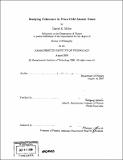Studying coherence in ultra-cold atomic gases
Author(s)
Miller, Daniel E. (Daniel Edward)
DownloadFull printable version (33.52Mb)
Other Contributors
Massachusetts Institute of Technology. Dept. of Physics.
Advisor
Wolfgang Ketterle.
Terms of use
Metadata
Show full item recordAbstract
This thesis will discuss the study of coherence properties of ultra-cold atomic gases. The atomic systems investigated include a thermal cloud of atoms, a Bose-Einstein condensate and a fermion pair condensate. In each case, a different type of measurement is performed. However, all of the experiments share a common tool: an optical lattice which is used to probe these atomic gases. In the first case, we use an auto-correlation technique to study the interference pattern produced by a gas of atoms, slightly above the Bose -Einstein condensate transition temperature. A moving optical lattice is used to split and recombine the single particle atomic wavefunction. Analogous to a Young's double slit experiment, we observe high contrast interference which is well described by the model which we develop. When we address only a velocity subset of the thermal sample, however, the contrast is enhanced and deviates from this model. In a second experiment we measure the coherence of a diatomic molecular gas, as well as the atomic Bose-Einstein condensate from which it was created. We use Bragg spectroscopy, in which atoms exchange photons with a moving optical lattice, transferring momentum to the atoms. This process can reveal the velocity distribution of the sample as energy and momentum are conserved only for a specific velocity class. Based on this measurement, we find that the atomic coherence is transferred directly to the molecular gas. We also discuss similar preliminary measurements performed on a fermion pair condensate in the BEC-BCS crossover. In a third experiment we study a fermion pair condensate into a 3D optical lattice. Such a system shares many similarities with electrons in solid materials which exhibit superconductivity, and can offer insight into mechanism which result in this behavior. We infer coherence from the sharp interference pattern observed in the expanding gas, after release. Finally, we study the abrupt onset of dissipation observed in a fermion pair condensate, as a function of velocity, in a moving optical lattice. (cont.) We equate this threshold with the Landau critical velocity, and take measurements throughout the BEC-BCS crossover. The critical velocity is found to be maximum near unitarity, where the loss mechanism is predicted to crossover from phonon-like excitations to pair breaking.
Description
Thesis (Sc. D.)--Massachusetts Institute of Technology, Dept. of Physics, September 2007. Includes bibliographical references (leaves 130-141).
Date issued
2007Department
Massachusetts Institute of Technology. Department of PhysicsPublisher
Massachusetts Institute of Technology
Keywords
Physics.